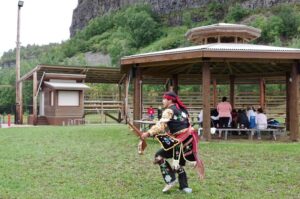Anishinaabe youth completes Basic Military Qualification in hopes to honour family legacy and the Anishinabek

By Rick Garrick
CAMP MEAFORD, ST. VINCENT TOWNSHIP — M’Chigeeng First Nation’s Pierre Debassige recently completed his Basic Military Qualification (BMQ) at Camp Meaford and is now looking forward to continuing on with infantry training with the Canadian Armed Forces.
“What got me interested in the military is my family history; I’ve had family in every major conflict since the American Revolution,” says Debassige, an Anishinabek Nation Eshki-niigijig Advisory Council member. “It’s always been a path that I’ve wanted to do since I was small. I’m caribou clan — growing up I was told we were always the ones making sure everybody in our communities was OK, their mental, their spiritual, and their physical well-being.”
Debassige says he wants to serve in the military to honour his family’s legacy and the sense of duty of serving the Anishinabek people, noting that has already been serving the Anishinabek people since high school.
“I sit on the Anishinabek Nation Youth Council, I have helped start youth councils,” Debassige says. “A lot of the people that I look up to served our people, whether they were police officers, military, any sort of first responder. Going back to my family history, a lot of my family members and ancestors were chiefs and they were always serving our people, they were always thinking of our people before they thought about themselves.”
Debassige says his path on the youth councils has taught him about what it means to be a leader.
“It helps me in this path I’m choosing now because I kind of have a grasp on what it takes or what it means to be a leader,” Debassige says, noting that he motivated his platoon mates during BMQ. “Things were going to get really hard but I always encouraged everybody, I always made sure everybody in my platoon was OK.”
Debassige says he participated in the Canadian Armed Forces Grey Wolf program, which is open to Indigenous people living across Ontario, during BMQ.
“The entirety of my platoon was Indigenous youth and young adults so I was able to connect with a lot of them on the struggles that we all shared through those two months of basic training,” Debassige says. “We did our rifle training, that was about maybe a week-and-a-half, essentially where we learned about the main service rifle in the Canadian Armed Forces, we learned how to take it apart and obviously how to shoot.”
Debassige says they also did an obstacle course to test their physical fitness and how they would work together as a team to get over some obstacles.
“There was a six-foot wall where we all had to work as a team to get everybody over,” Debassige says. “We did map and compass, so we learned how to navigate around base using just a map and compass and plotting courses with a compass.”
Debassige says they also did assault boat training on the water with assault boats.
“We learned how they work and how we’d use them in an operational setting,” Debassige says.
Debassige says they also went for a week to CFB Borden near Barrie for the experimental learning week.
“They showed us all the different options you can go into in the military,” Debassige says.
Debassige says he decided to do the Infanteer trade option, which involves training to be an infantry soldier, and is trying to get into an infantry course as soon as possible.
“It’s a six or seven-week course on what my trade is and that course goes more into depth about the infantry,” Debassige says. “We learn how to dig trenches and go out into the field a little bit more and things like that. Once I complete that course, I’m a qualified infanteer, or infantry soldier in the Canadian Armed Forces.”
Debassige says his grandfather, great grandfather, great great grandfather, and great great great grandfather served during World War I and II, and the Korean War.
“Hearing of the feats they accomplished and hearing of different First Nations people like Francis Pegahmagabow and Tommy Prince being some of the most decorated First Nations soldiers in all of Canada and hearing of the things they did really inspired me to want to be part of the Armed Forces and continue on that legacy, not just for my family but for all of our people,” Debassige says, noting that one of his ancestors, who served in World War I, was always the first to volunteer for trench raiding. “Hearing stories of him going over the top, as they used to say in World War I, and sneaking into enemy trenches and taking things, whether it be maps, information, prisoners, it always put me on the edge of my seat when I was small. It was exciting, it was thrilling to hear that but also the dangers of what that entailed.”
Debassige says one of his great uncles was wounded in the arms during World War I by shrapnel from an artillery shell.
“Hearing the story of how he came back home was incredible,” Debassige says. “He was discharged from the military with medals for being wounded. With all the money he earned while being in the military, he came back to my community and he opened up a store where he could sell [food] like eggs and fresh produce. So the stories of my family just make me super proud and I want to carry on that legacy.”

